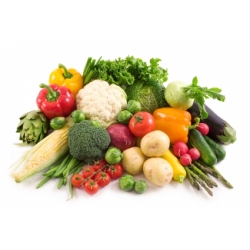I rabbit on about portion control a lot. It's a vital part of controlling the grocery bill.
It is very hard not to overeat when portions have become so very large. Coffee and cake is now the energy equivalent of a day's food intake. A slice of cake is almost big enough to feed a small nation!
Modern dinner plates don't help either, they are very big, about twice the size they were 30 years ago. That doesn't mean they were designed for us to fill them with more food, they were just designed to look different. When a normal sized meal is served on them they look empty.
It's a trick of the eye, and of course we keep piling on the food until our eye tells us there is "enough" on the plate. Enough was probably quite a few kilojoules earlier.
And that's when we really need to remember portion control. It's easy to say, not so easy to actually put into practice.
The Australian Government has put together a chart at
www.measureup.gov.au outlining portion sizes and it gives a very good general idea of just what a portion of most common foods is.
Here are some examples of one serve for various food groups (as listed on the Measure Up website):
Cereals, breads, rice, pasta, noodles
• 2 slices of bread; 1 medium bread roll; 1 cup cooked rice, pasta, or noodles
• 1 cup porridge, 1 cup breakfast cereal flakes, or ½ cup muesli
Vegetables and legumes (choose a variety)
• Starchy vegetables: 1 medium potato/yam, ½ medium sweet potato, 1 medium parsnip
• Dark green leafy vegetables: ½ cup cabbage, spinach, silverbeet, broccoli, cauliflower or Brussels sprouts
• Legumes and other vegetables: 1 cup lettuce or salad vegetables; ½ cup broad beans, lentils, peas, green beans, zucchini, mushrooms, tomatoes, capsicum, cucumber, sweet corn, turnips, sprouts, celery, eggplant etc.
Fruit
• 1 piece medium sized fruit (e.g. apple, orange, mango, banana, pear, etc)
• 2 pieces of smaller fruit e.g. apricots, kiwi, plum, figs, etc, about 8 strawberries, about 20 grapes or cherries, ½ cup (125ml) fruit juice (sugar free), ¼ medium melon (eg. rockmelon)
• Dried fruit e.g. 4 dried apricots or 1½ tablespoon sultanas
• 1 cup diced pieces/canned fruit
Milk, yoghurt, cheese & alternatives
• 250 ml glass or one cup of milk (can be fresh, long life or reconstituted milk)
• ½ cup evaporated milk, 40g (2 slices) cheese or 250ml (1 cup) of custard
• 200g (1 small carton) of plain or fruit yoghurt
• 1 cup of calcium-fortified soy milk, 1 cup almonds, ½ cup pink salmon with bones
Meat, fish, poultry & alternatives
• 65-100gm cooked meat/chicken (e.g. ½ cup mince, 2 small chops, or 2 slices roast meat)
• 80-120g cooked fish fillet,
• 2 small eggs, ⅓ cup cooked dried beans, lentils, chickpeas, split peas or canned beans, or 1/3 cup peanuts/almonds
Extras
Foods which we can occasionally include for variety. They are generally higher in fat and/or sugar, kilojoules, salt etc.
• 1 medium slice of plain cake or 1 bun, 3-4 plain sweet biscuits, half a small chocolate bar, 60g jam, honey (1 tablespoon), 30g (1/2 a small packet) potato crisps, 1 slice pizza = 2 extras
• 1 can soft drink or 2 glasses cordial, 2 scoops ice-cream, 1 meat pie or pasty = 3 extras
• 2 standard glasses of alcohol (for adults only)
• 1 tablespoon (20g) butter, margarine, oil
Take special note of the extras. That can of Coke you enjoyed at lunchtime is the equivalent of three serves!
When you are meal planning you are planning on the number of serves you need for your family. You do this so you know how much to buy and how much to prepare.
To keep your grocery bill really low you need to know exactly how much of each food you need for the week and the only accurate way to do this is to measure it.
Now that may seem a little OTT but it's the only way. Right now you might think you need 1kg of peas every week but do you? Or do you just buy 1kg of peas every week? With a serve of peas being half a cup, I need two and a half cups for every meal I plan to serve peas. That means from a 1kg packet of frozen peas I'll get approximately 3 meals (there are approximately 8 cups of peas in a kilo, and half a cup of frozen peas weighs 65g).
Knowing that I can accurately buy what I need.
Ah, I hear you say. But what about if you stockpile? I do. I don't buy frozen peas every week, or even every shop. That's OK. I still know that a portion is half a cup, and that I get 15 serves from a kilo, and we have peas 3 times a week, so when peas come on sale I know roughly how many packets I'll need to last until the next sale.
If you are not sure what half a cup of peas or 100g of meat looks like, measure or weigh it. Being accurate isn't something to be ashamed of and you are not being mean, it is an essential part of controlling your money and maintaining good health. Get out the measuring cups and the scales and use them when you dish up.
Fool your eye too. Place the food in the bowl of the plate, nicely arranged. Take it up to the inner edge of any rim, but don't go over it. You don't see Masterchef contestants filling the plate to the edge do you? Actually they don't even fill the bowl of the plate, and while I am not sure Masterchef meals are budget friendly or even healthy everyday food, the fact that portion control is practiced is one good thing to come from the show.
It really is easy.
But even if you don't want to go quite that far, remembering portion sizes and sticking to them will help you keep better control of your grocery bill.
And a side benefit will be your health. Not over-eating will help you control your weight, and controlling your weight will help with so many other potential health issues (and save you even more money).


































.jpg)


